20 Artist Samples
plagued by longing 2024- ONGOING RESEARCH
![]()
plagued by longing, 2024. Resin, pigment, gloves, and a peacock feather. 29.5 x 14.5 x 0.5 in.
![]()
![]()
you would find me if you were trying II, 2024 Resin, historic family photograph on transparency, necklace, and pigment. 20.5 x 8.5 in
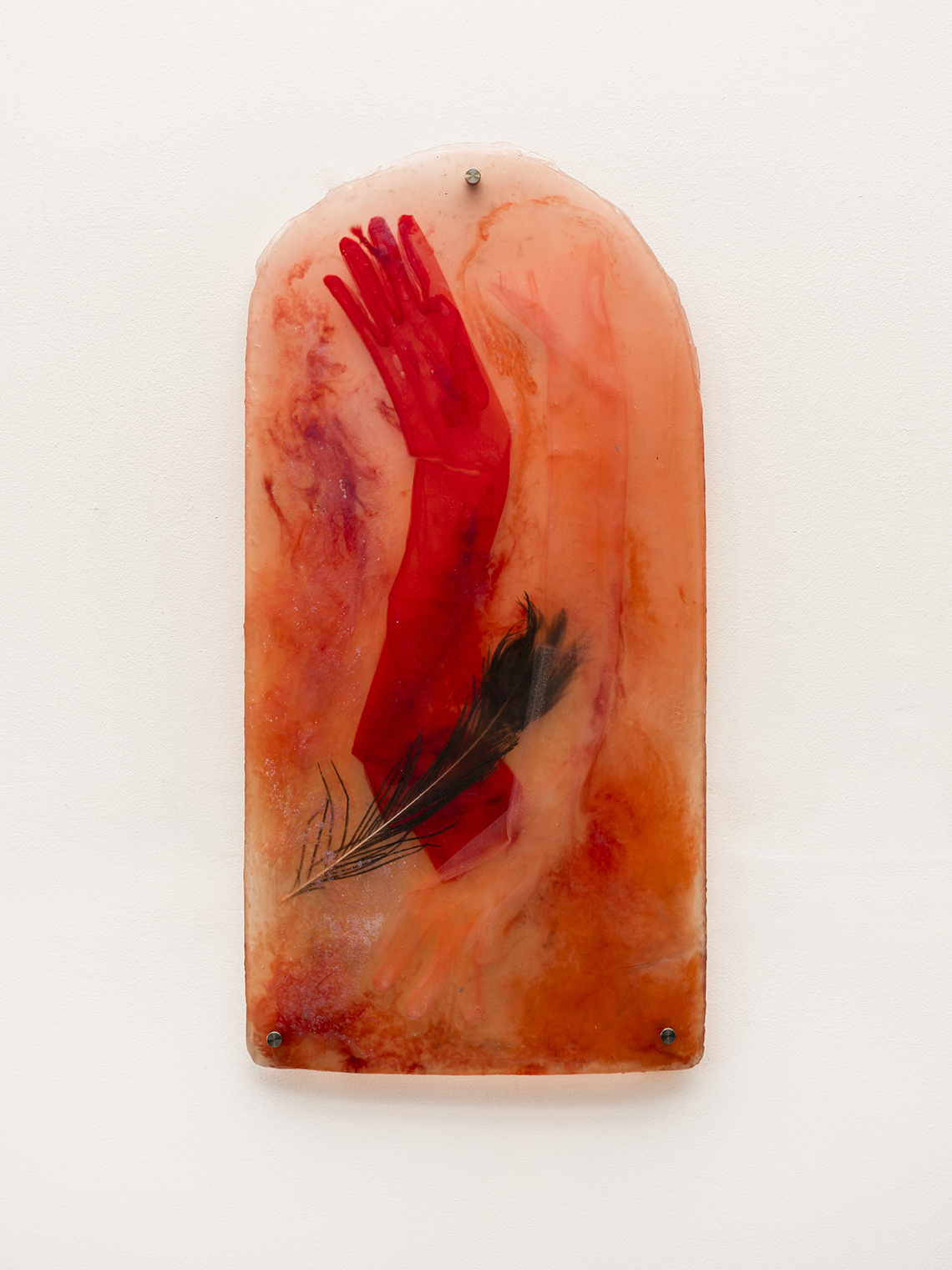
1.
plagued by longing, 2024. Resin, pigment, gloves, and a peacock feather. 29.5 x 14.5 x 0.5 in.

2.
could you let me go II (study for large scale sculpture), 2024.
Resin, pigment, epoxy clay, volcanic sand, peacock feathers, ceramic, necklace chain, acrylic paint, and painters tape.
20 x 13 x 2.5 in
Resin, pigment, epoxy clay, volcanic sand, peacock feathers, ceramic, necklace chain, acrylic paint, and painters tape.
20 x 13 x 2.5 in
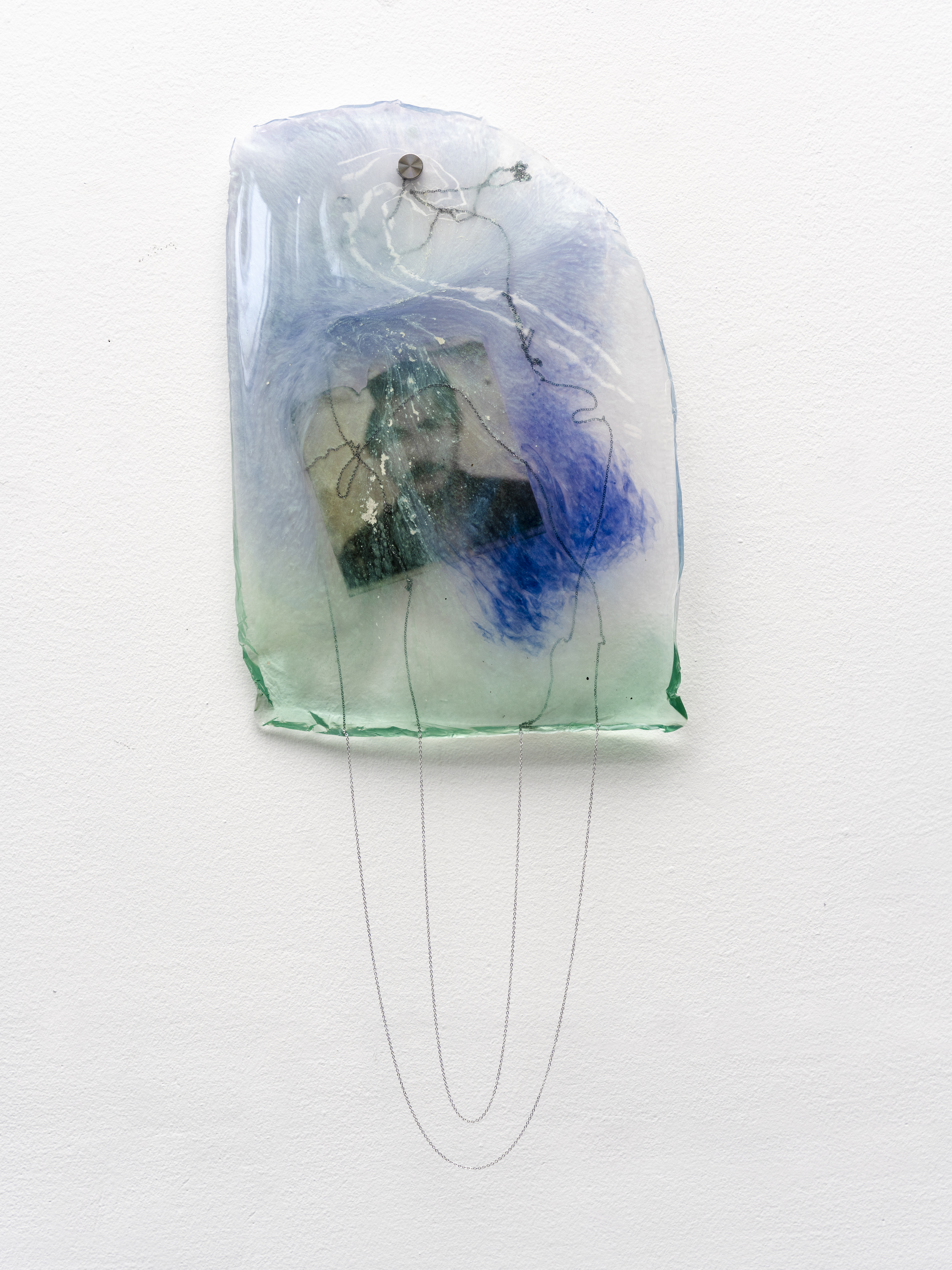
3.
you would find me if you were trying II, 2024 Resin, historic family photograph on transparency, necklace, and pigment. 20.5 x 8.5 in
In 2004, my father survived a heart attack and seizure, undergoing a near-death experience (NDE) during the ten minutes he was clinically dead. This event caused permanent short-term memory loss, subsequently leading to dementia. The work begins with his NDE account, a repeated narrative that grounds him amidst confusion. The story has been a conduit to traverse his memories: growing up in the Philippines, immigrating to America, and his longing to return to our motherland. The lapse in his memories mirrors the blurry precolonial histories in the Philippines, overshadowed by colonial influence.
This body of work follows my father's narrative to drive my investigations of recovering my family’s history, while contextualizing it within the colonial history of the Philippines. Storytelling is used as a making process that pulls from a lived experience. Through retelling, elements shift and change, transforming the narrative into something different: a complicated record that fuses the past and the present via the storyteller. As my father's dementia affects his memories, through recounting his experiences, nuances evolve depending on his current state, tangling the past, present, and future within the narrative.
Rather than simply verbalizing the tale, I engage in a psychosomatic process, locating tensions within my body that have absorbed the story. I then transform materials through collapsing and extending them into forms that echo my body's repository of inherited experiences.
photo documentation by Matt Savitsky
This body of work follows my father's narrative to drive my investigations of recovering my family’s history, while contextualizing it within the colonial history of the Philippines. Storytelling is used as a making process that pulls from a lived experience. Through retelling, elements shift and change, transforming the narrative into something different: a complicated record that fuses the past and the present via the storyteller. As my father's dementia affects his memories, through recounting his experiences, nuances evolve depending on his current state, tangling the past, present, and future within the narrative.
Rather than simply verbalizing the tale, I engage in a psychosomatic process, locating tensions within my body that have absorbed the story. I then transform materials through collapsing and extending them into forms that echo my body's repository of inherited experiences.
photo documentation by Matt Savitsky
Smoking in the Garden at Phase Gallery, Los Angeles
Solo Exhibition, May 13 - June 10, 2023.
![]()
remedies, 2023. Epoxy clay, resin, peacock feathers, medical casting tape, polymer gypsum, necklace chains, and half empty sake bottle.
48 x 203 x 24 in.
![]()
Installation documentation of exhibition.
![]()
circling you like the ocean, 2023. Polymer gypsum, resin, acrylic paint, fiberglass, and ceramic. 84 x 47 x 37 in.
![]()
circling you like the ocean (detail), 2023. Polymer gypsum, resin, acrylic paint, fiberglass, and ceramic. 84 x 47 x 37 in.
![]()
this body remembering yours, 2023. Resin, epoxy clay, peacock feathers, braided rope, glass, enamel and steel charms. . 120 x 549 x 12 in.
![]()
this body remembering yours (detail), 2023. Resin, epoxy clay, peacock feathers, braided rope, glass, enamel and steel charms. . 120 x 549 x 12 in.
Solo Exhibition, May 13 - June 10, 2023.
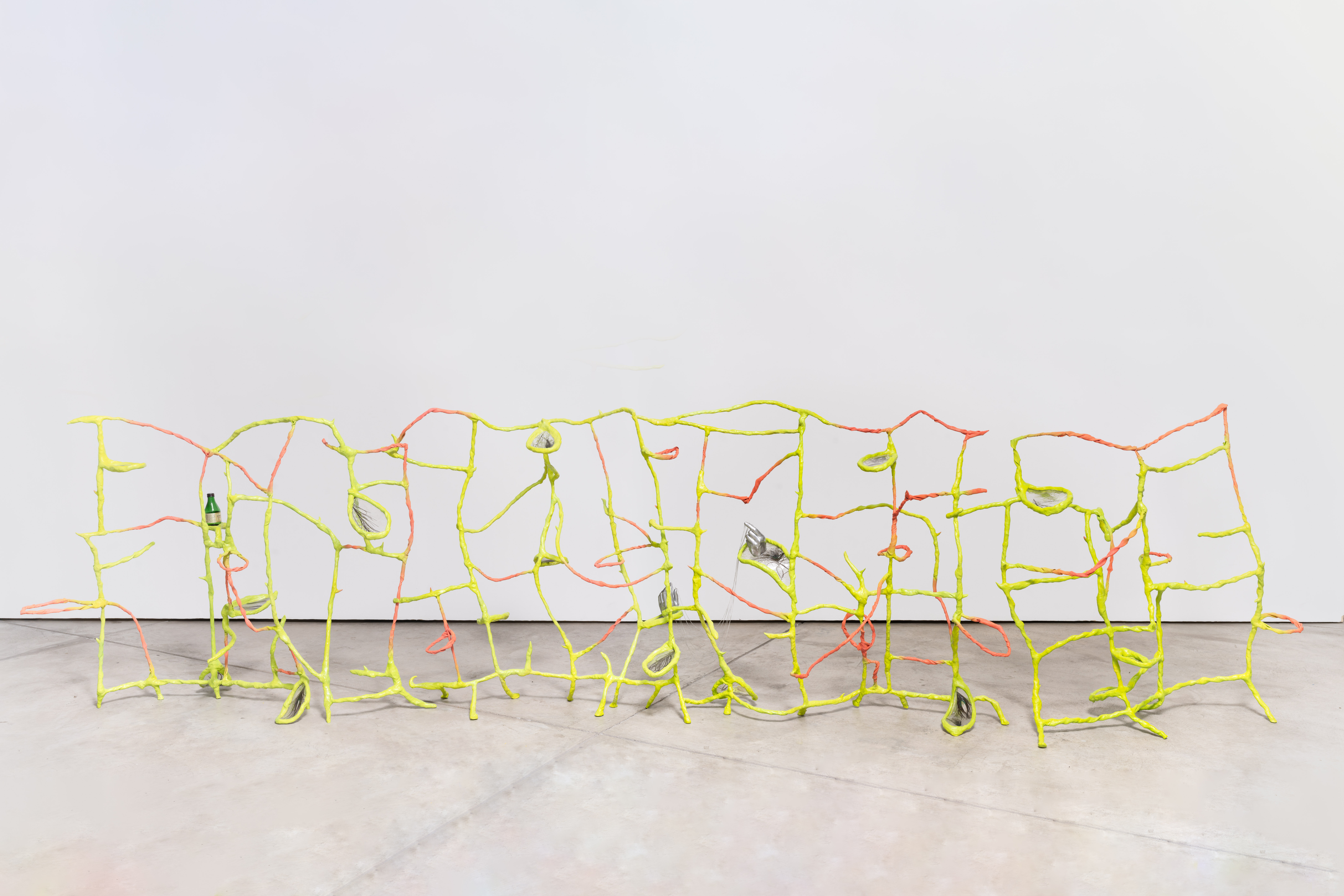
4.
remedies, 2023. Epoxy clay, resin, peacock feathers, medical casting tape, polymer gypsum, necklace chains, and half empty sake bottle.
48 x 203 x 24 in.

5.
Installation documentation of exhibition.

6.
circling you like the ocean, 2023. Polymer gypsum, resin, acrylic paint, fiberglass, and ceramic. 84 x 47 x 37 in.

7.
circling you like the ocean (detail), 2023. Polymer gypsum, resin, acrylic paint, fiberglass, and ceramic. 84 x 47 x 37 in.
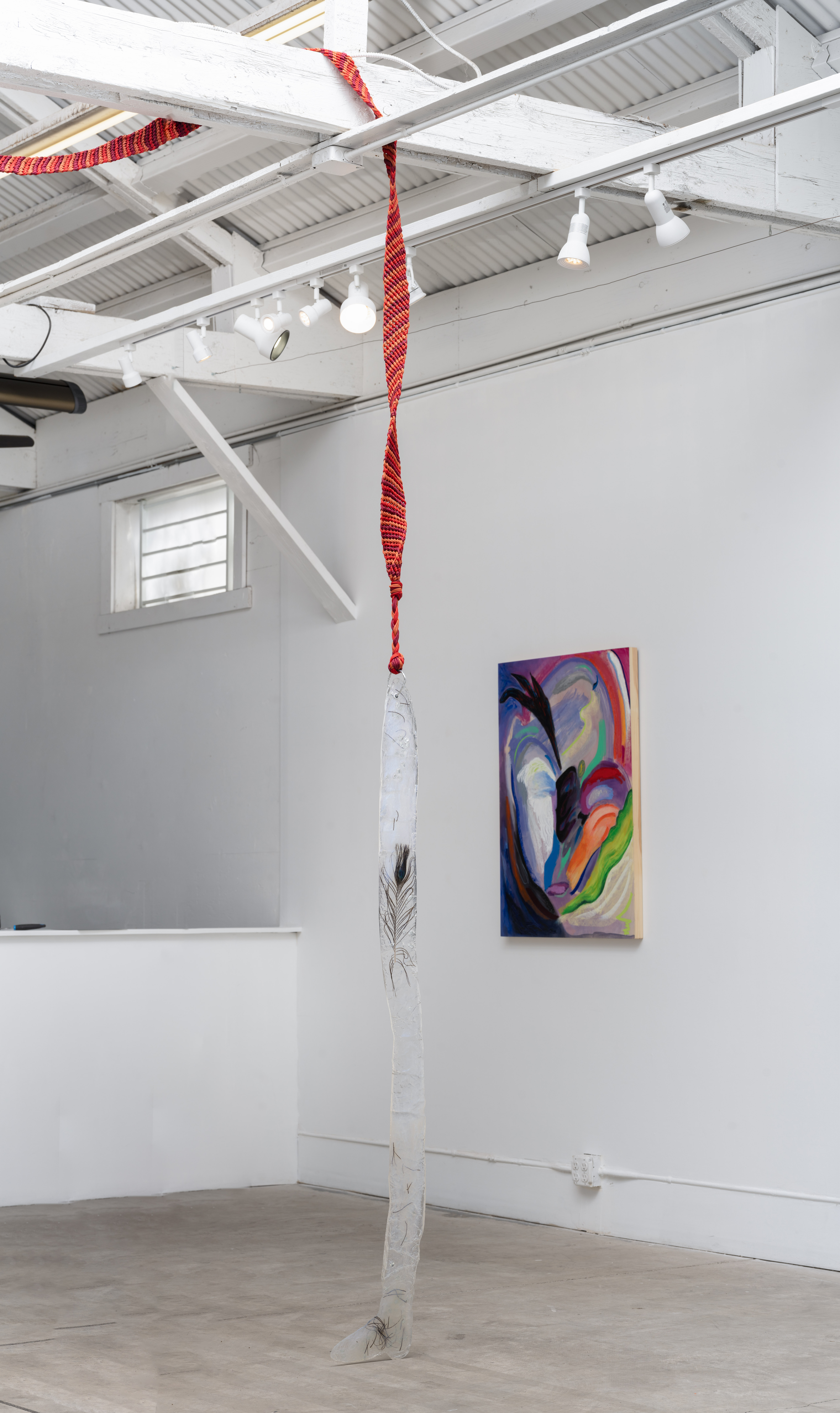
8.
this body remembering yours, 2023. Resin, epoxy clay, peacock feathers, braided rope, glass, enamel and steel charms. . 120 x 549 x 12 in.
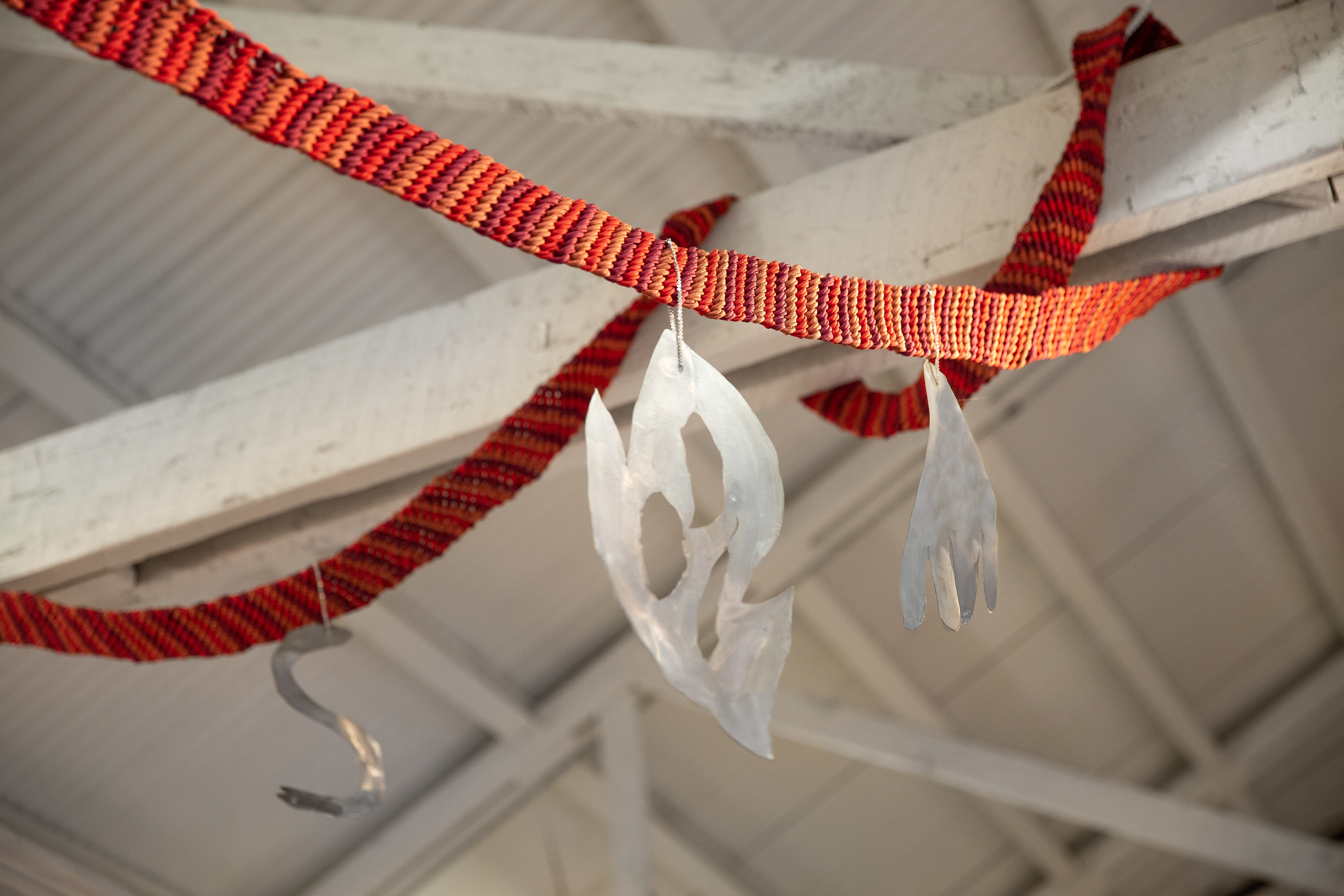
9.
this body remembering yours (detail), 2023. Resin, epoxy clay, peacock feathers, braided rope, glass, enamel and steel charms. . 120 x 549 x 12 in.
Smoking in the Garden explores folklore from stories passed down through Kim’s mother, investigating how an oral narrative can transform trauma into power. These works express how her body and lived experiences digest intimacy while employing memory, in all of its slipperiness, to explore interpersonal power dynamics. Using the trace of history as a key element in her work, Kim's material practice combines sculpture, drawing, and painting to investigate residual tensions built up to the present. This latest body of work is a form of sincere and sentimental inscription, describing the love entwined in a mother-daughter relationship and the postcolonial identity in all its cryptic layers.
Love is traditionally something that must be upkept, where stains can both hide and reveal what is lacking in a relationship. From the repeated performance of this oral history, meaning is brought forth from the realm of the imaginary through material play. Kim herself acknowledges that each story is interlaced with familial and colonial trauma - an inheritance she is conscious of as the daughter of immigrants. Walking through those shadows as an act of care and remembrance, Kim uses her material process to ritualize these narrative moments into a healing practice. To stand with her shadow self and the shadows that have come before her time, Kim gives power to the absent: what isn't visible, what may be powerless, and what cannot be easily defined.
Simulating the oral narrative recited by her mother, Kim uses repeated visuals that shift in scale and move through the planes of a surface. Forms from this series collapse in certain areas and expand in others, functioning both as supporting tissues and objects that dominate space. Punctures on surfaces disintegrate the visible membrane between here and there. Much like recalling the past, the textures of the surface are gooey, thick, layered, slimy, and agitated. The work contends with history outside the conventions of a linear timeline. Color becomes a connotative device to evoke complicated moments in a relationship, like the operation of warmth and intensity on one side and rejection or harm on the other.
The show takes its title from Kim's middle name Fumar, inherited from her mother, which translates from Spanish to English to smoke. Its amorphous state of being is the product of some material cannibalization into a gas – in most cultures, it can purify or contaminate bodies. It is a verb with affect, agency, and change, all inherent in its meaning. In Smoking in the Garden, Kim presents a world arrested between fiction and history, here and there, self and other.
Written by Liz Stringer is an artist and writer living in Los Angeles
Additional accompanying Texts: Reflections on the Ashtray by Lawrence Chit and Letter to Kim Garcia from Liz Stringer
Photo documentation by Yubo Dong ofstudio photography
Love is traditionally something that must be upkept, where stains can both hide and reveal what is lacking in a relationship. From the repeated performance of this oral history, meaning is brought forth from the realm of the imaginary through material play. Kim herself acknowledges that each story is interlaced with familial and colonial trauma - an inheritance she is conscious of as the daughter of immigrants. Walking through those shadows as an act of care and remembrance, Kim uses her material process to ritualize these narrative moments into a healing practice. To stand with her shadow self and the shadows that have come before her time, Kim gives power to the absent: what isn't visible, what may be powerless, and what cannot be easily defined.
Simulating the oral narrative recited by her mother, Kim uses repeated visuals that shift in scale and move through the planes of a surface. Forms from this series collapse in certain areas and expand in others, functioning both as supporting tissues and objects that dominate space. Punctures on surfaces disintegrate the visible membrane between here and there. Much like recalling the past, the textures of the surface are gooey, thick, layered, slimy, and agitated. The work contends with history outside the conventions of a linear timeline. Color becomes a connotative device to evoke complicated moments in a relationship, like the operation of warmth and intensity on one side and rejection or harm on the other.
The show takes its title from Kim's middle name Fumar, inherited from her mother, which translates from Spanish to English to smoke. Its amorphous state of being is the product of some material cannibalization into a gas – in most cultures, it can purify or contaminate bodies. It is a verb with affect, agency, and change, all inherent in its meaning. In Smoking in the Garden, Kim presents a world arrested between fiction and history, here and there, self and other.
Written by Liz Stringer is an artist and writer living in Los Angeles
Additional accompanying Texts: Reflections on the Ashtray by Lawrence Chit and Letter to Kim Garcia from Liz Stringer
Photo documentation by Yubo Dong ofstudio photography
The HIDEBEHIND ONGOING RESEARCH
Collaborative Exhibition at after hours gallery, Los Angeles, August 7-20, 2021.
![]()
The HIDEBEHIND Installation documentation at after hours gallery, August 7-20, 2021. Sculptures by Kim Garcia and paintings by Amy MacKay.
![]()
The HIDEBEHIND Installation documentation at after hours gallery, August 7-20, 2021. Sculptures by Kim Garcia and paintings by Amy MacKay.
Collaborative Exhibition at after hours gallery, Los Angeles, August 7-20, 2021.

10.
The HIDEBEHIND Installation documentation at after hours gallery, August 7-20, 2021. Sculptures by Kim Garcia and paintings by Amy MacKay.

11.
The HIDEBEHIND Installation documentation at after hours gallery, August 7-20, 2021. Sculptures by Kim Garcia and paintings by Amy MacKay.
The HIDEBEHIND is an ongoing collaborative dialogue by myself and Amy MacKay. The project draws inspiration from the American myth of the Hidebehind, a forest-dwelling monster known for its ability to conceal itself. With a history of sharing a studio space for over 9 years and collaborating on various works and community projects, the series investigates the dynamics of coexistence and our responses to encountering difference. Through the interaction of painting and sculpture, THE HIDEBEHIND explores our intimate relationship and the interplay between these art forms.
Amy MacKay is a painter based in Los Angeles, CA.
photo documentation by Yubo Dong ofstudio photography
Amy MacKay is a painter based in Los Angeles, CA.
photo documentation by Yubo Dong ofstudio photography
She has her mother’s eyes series
This series led up to the exhibition, Smoking in the Garden, at Phase Gallery Los Angeles on May 13, 2023.
![]()
resting on a blade, 2022. Polymer gypsum, epoxy resin, acrylic paint, and enamel. 50 x 25 x 29 in.
Installation at Beta Epochs group show, work is a part of the She has her mother’s eyes series.
This series led up to the exhibition, Smoking in the Garden, at Phase Gallery Los Angeles on May 13, 2023.
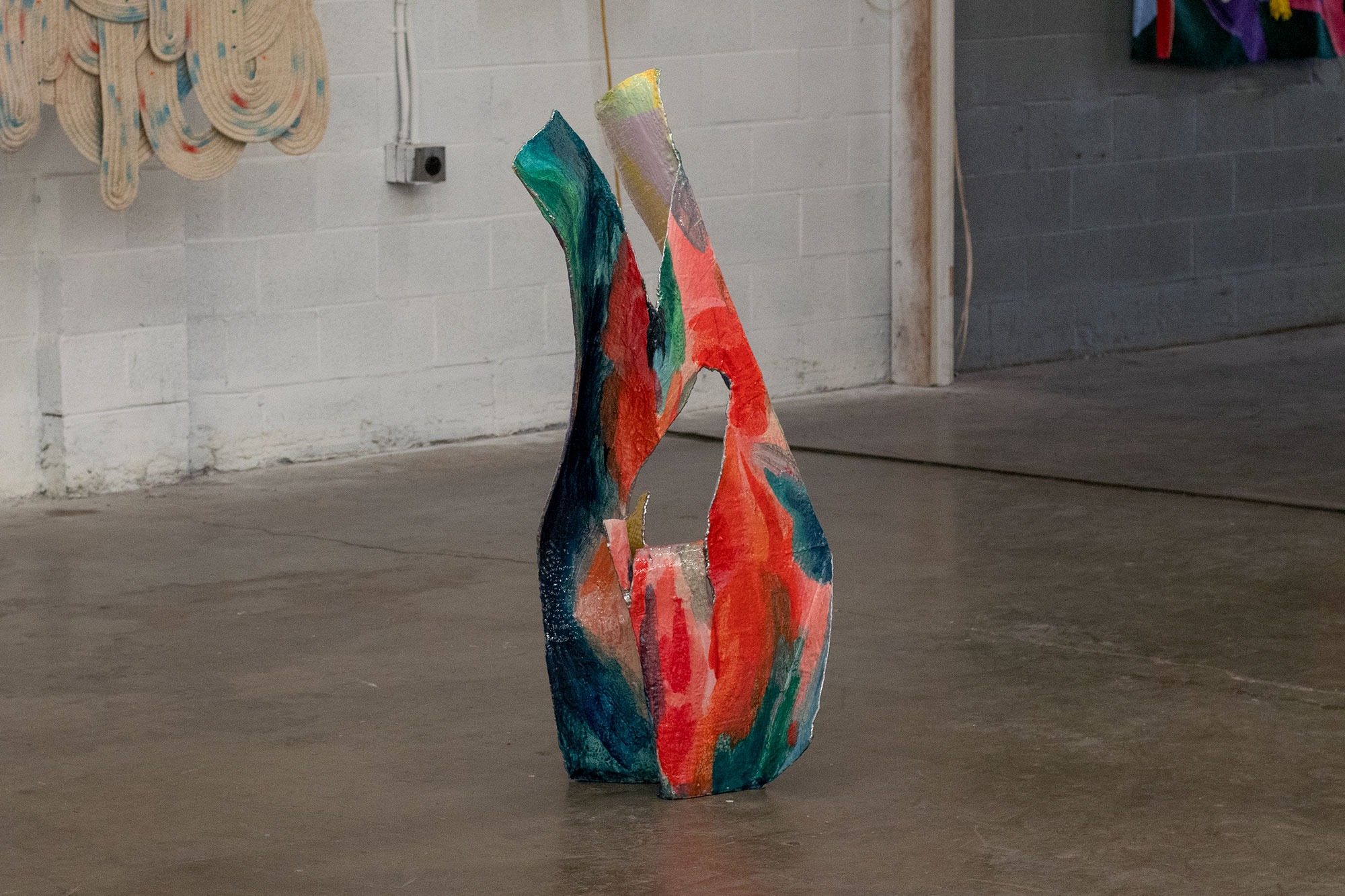
12.
resting on a blade, 2022. Polymer gypsum, epoxy resin, acrylic paint, and enamel. 50 x 25 x 29 in.
Installation at Beta Epochs group show, work is a part of the She has her mother’s eyes series.
In 2019, I began a series exploring folklore passed down by my mother, delving into its significance as a fantastical origin tale of her family history. This creative endeavor also served as a cathartic process, addressing trauma spanning our mother-daughter bond, familial ties, and the history of the Philippines.
Spain's publication of the "Catálogo alfabético de apellidos" in 1849 established a system for selecting last names. Indigenous Filipinos chose surnames alphabetically, yet I discovered no mention of Fumar, my mother's maiden name, within the document. Although it likely deviated slightly, it intrigued me due to its translation as "to smoke.”
The interplay between smoke and the surname mirrors my mother's ever-evolving narrative. The name itself encompasses the entire story, reflecting its transformations, adaptations, and reconstructions to convey strength while still bearing the imprints of trauma. This ongoing series explores intergenerational trauma and the complex dynamics of power and wounds.
Spain's publication of the "Catálogo alfabético de apellidos" in 1849 established a system for selecting last names. Indigenous Filipinos chose surnames alphabetically, yet I discovered no mention of Fumar, my mother's maiden name, within the document. Although it likely deviated slightly, it intrigued me due to its translation as "to smoke.”
The interplay between smoke and the surname mirrors my mother's ever-evolving narrative. The name itself encompasses the entire story, reflecting its transformations, adaptations, and reconstructions to convey strength while still bearing the imprints of trauma. This ongoing series explores intergenerational trauma and the complex dynamics of power and wounds.
i leave this standing stone to be a sign at Best Practice, San Diego
Solo Exhibition, March 16 - April 13, 2019.
![]()
![]()
Solo Exhibition, March 16 - April 13, 2019.
![]()
13.
i leave this standing stone to be a sign installation documentation at Best Practice gallery. March 16 - April 23, 2019.

13.
i leave this standing stone to be a sign installation documentation at Best Practice gallery. March 16 - April 23, 2019.

14.
gathering, 2019. Polymer gypsum, acrylic latex paint, unfired clay, watercolor, wax, plaster, and epoxy. 11 x 62 x 41 in.
14.
gathering, 2019. Polymer gypsum, acrylic latex paint, unfired clay, watercolor, wax, plaster, and epoxy. 11 x 62 x 41 in.

15.
all fours, 2019. Polymer gypsum, acrylic latex paint, unfired clay, watercolor, wax, plaster, and epoxy. 11 x 62 x 41 in.
15.
all fours, 2019. Polymer gypsum, acrylic latex paint, unfired clay, watercolor, wax, plaster, and epoxy. 11 x 62 x 41 in.
i leave this standing stone to be a sign is an exhibition that skillfully weaves together materials and processes, creating forms both familiar and foreign. Through the lens of fiction, the work explores the intricate interplay among collaboration, interpersonal relationships, and community, immersing viewers in an engaging experience.
Low sculptures act as pedestals for smaller works, with vibrant red drawings mounted higher than the standard viewing experience. Visitors choose to crouch for intimate sculpture examination or lift their gaze to view the elevated drawings. Employing a layered approach to objects and imagery, the audience is invited to delve into the work's past and contemplate the lingering myths that remain. Fiction merges with reality, prompting a reconsideration of human connection and the power of shared and changing narratives.
‘standing stones’ were small sculptures that were comprised of a mixture of found objects, encapsulated objects, unfired clay, paraffin wax, watercolor, resin, powder pigment, oil pastel, and polyurethane foam.
Low sculptures act as pedestals for smaller works, with vibrant red drawings mounted higher than the standard viewing experience. Visitors choose to crouch for intimate sculpture examination or lift their gaze to view the elevated drawings. Employing a layered approach to objects and imagery, the audience is invited to delve into the work's past and contemplate the lingering myths that remain. Fiction merges with reality, prompting a reconsideration of human connection and the power of shared and changing narratives.
‘standing stones’ were small sculptures that were comprised of a mixture of found objects, encapsulated objects, unfired clay, paraffin wax, watercolor, resin, powder pigment, oil pastel, and polyurethane foam.
is love a tender thing? at the University Art Gallery at UCI
Solo Exhibtion, April 28 - May 12, 2018.
![]()
![]()
is love a tender thing? Installation at the University Art Gallery at UC Irvine, April 28 - May 12, 2018.
![]()
19.
lost objects become like the sphinx, 2018. Polymer gypsum, epoxy resin, enamel, unfired clay, pigment, and wax. 37 x 18 x 27 in.
![]()
is love a tender thing? Installation documentation at the University Art Gallery at UC Irvine, April 28 - May 12, 2018.
Solo Exhibtion, April 28 - May 12, 2018.
![]()
16.
is love a tender thing? Installation at the University Art Gallery at UC Irvine, April 28 - May 12, 2018.

16.
is love a tender thing? Installation at the University Art Gallery at UC Irvine, April 28 - May 12, 2018.

17.
Boulders resting on a blade, 2018. Polymer gypsum, acrylic latex paint, rope and wood. 92 x 60 x 48 in.
17.
Boulders resting on a blade, 2018. Polymer gypsum, acrylic latex paint, rope and wood. 92 x 60 x 48 in.
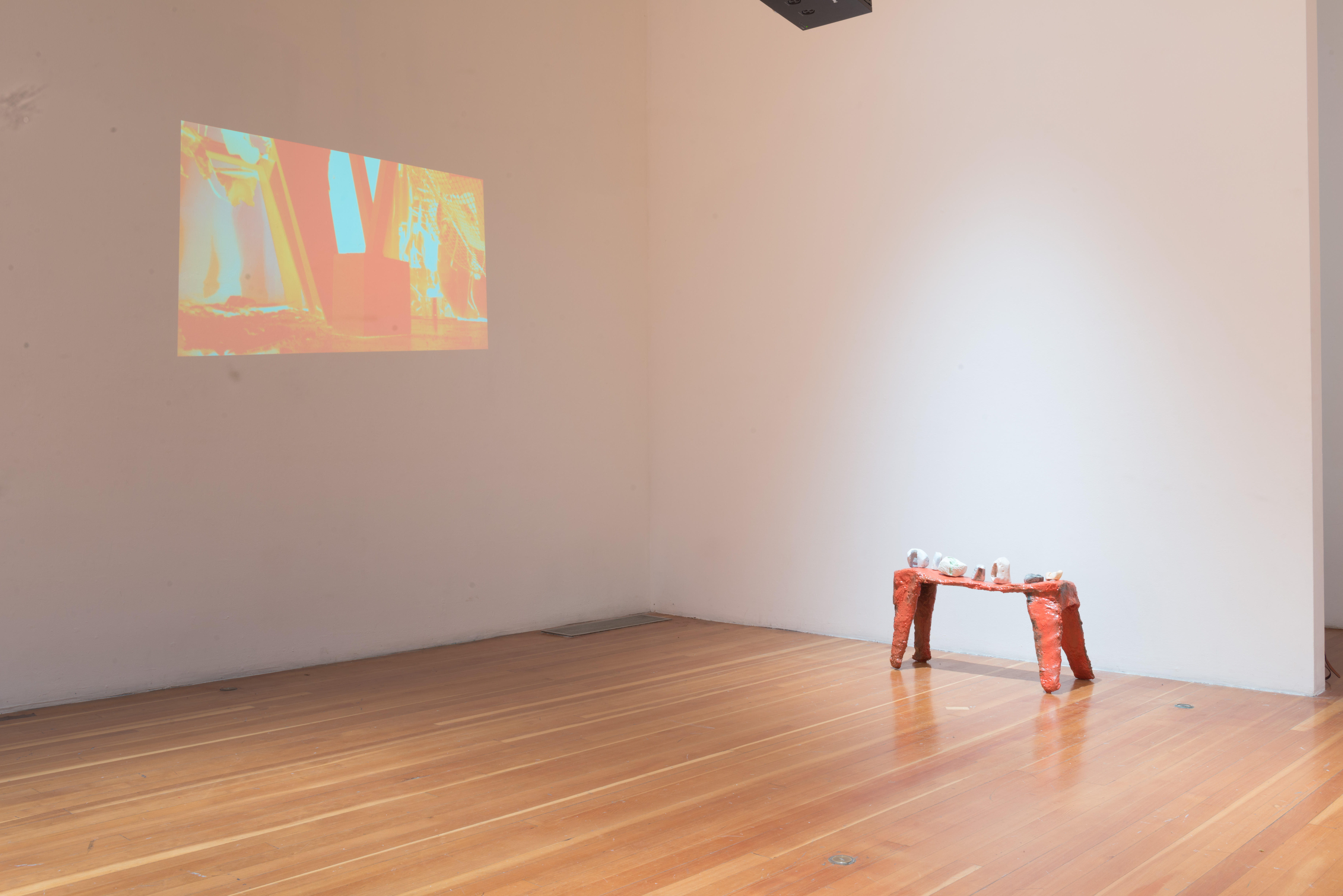
18.
is love a tender thing? Installation at the University Art Gallery at UC Irvine, April 28 - May 12, 2018.
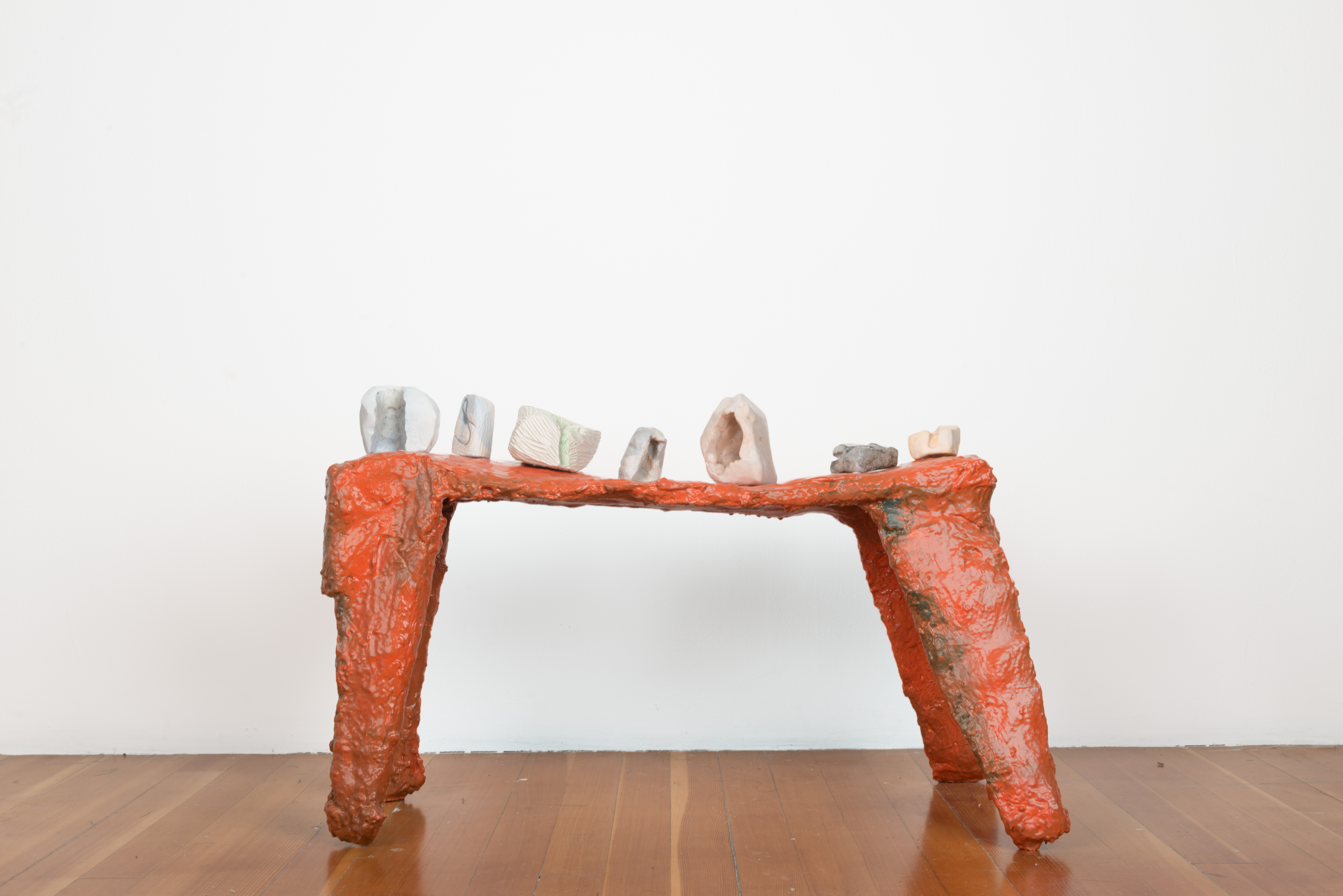
19.
lost objects become like the sphinx, 2018. Polymer gypsum, epoxy resin, enamel, unfired clay, pigment, and wax. 37 x 18 x 27 in.
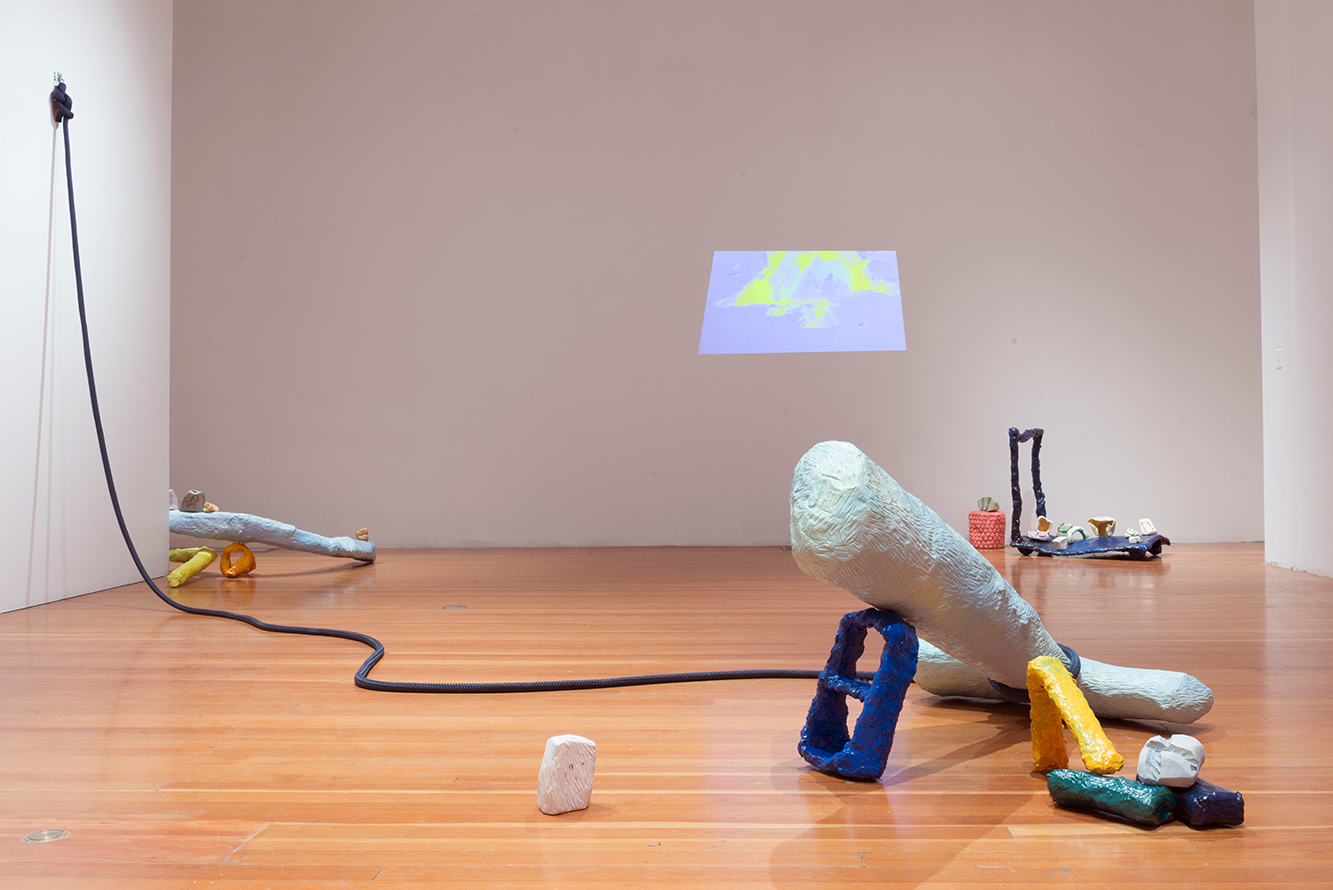
20.
is love a tender thing? Installation documentation at the University Art Gallery at UC Irvine, April 28 - May 12, 2018.
is love a tender thing? negotiates the boundaries within relationships: the misunderstandings between people through gestures of sincerity, the gravity between bodies through weight and tension amongst the sculptural objects and their influence of navigation through the viewing space. A relationship’s residual impressions often having consequences that are guided by micro-disconnections and are often forgotten and then accumulated. The works present are fueled by images of archived past collaborations. The impetus to enact this gesture was to turn a critical lens to explore what we hope to gain through connecting with others. Within the structures of community, there are always inherent disconnections that are left unsaid. How can we effectively connect with others without dissolving ourselves and how could we possibly reorganize to make a space for another way of thinking about connection within community?
The sculptural objects and video works began by staging a re-membering of past collaborative projects between artists and friends who I deeply care for. The re-membered story was derived and directed from isolated vignettes of collaborative works that utilized unactivated architectural spaces for intuitive group responses to production and display. I constructed a video set that compressed these collaborations into one work, in space that physically replicated the University Art Gallery that the work would, and could be situated in. The fictionalizing act begins in the mediated retelling of the collaborative experiences. The mediation is the fictionalized act, as it occupies the space of what absent, describing an new experience formed through all that it excludes: the original collaborations, myself physically as collaborator, the origin and the original site.
The retelling is the vehicle for expressing a subjective truth, where I am consciously aware that this is a projection of the longing for connectivity and a desire for a space of belonging. The works in the exhibition are further mediations from the original story; its form deviated from its origin. Expanding into a new world built on the foundation of what is vacant, to become a new relationship of its own.
photo documentation by Yubo Dong ofstudio photography
The sculptural objects and video works began by staging a re-membering of past collaborative projects between artists and friends who I deeply care for. The re-membered story was derived and directed from isolated vignettes of collaborative works that utilized unactivated architectural spaces for intuitive group responses to production and display. I constructed a video set that compressed these collaborations into one work, in space that physically replicated the University Art Gallery that the work would, and could be situated in. The fictionalizing act begins in the mediated retelling of the collaborative experiences. The mediation is the fictionalized act, as it occupies the space of what absent, describing an new experience formed through all that it excludes: the original collaborations, myself physically as collaborator, the origin and the original site.
The retelling is the vehicle for expressing a subjective truth, where I am consciously aware that this is a projection of the longing for connectivity and a desire for a space of belonging. The works in the exhibition are further mediations from the original story; its form deviated from its origin. Expanding into a new world built on the foundation of what is vacant, to become a new relationship of its own.
photo documentation by Yubo Dong ofstudio photography
More images of work can be found on my website: kimgarcia.info